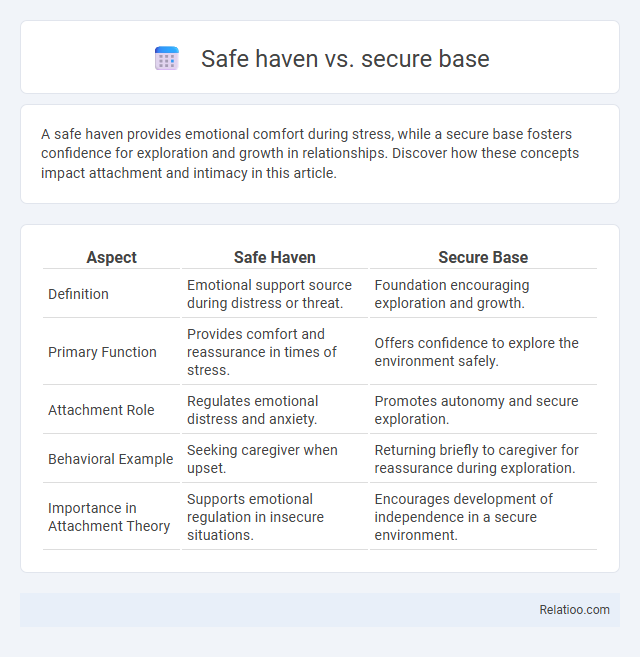A safe haven provides emotional comfort during stress, while a secure base fosters confidence for exploration and growth in relationships. Discover how these concepts impact attachment and intimacy in this article.
Table of Comparison
| Aspect | Safe Haven | Secure Base |
|---|---|---|
| Definition | Emotional support source during distress or threat. | Foundation encouraging exploration and growth. |
| Primary Function | Provides comfort and reassurance in times of stress. | Offers confidence to explore the environment safely. |
| Attachment Role | Regulates emotional distress and anxiety. | Promotes autonomy and secure exploration. |
| Behavioral Example | Seeking caregiver when upset. | Returning briefly to caregiver for reassurance during exploration. |
| Importance in Attachment Theory | Supports emotional regulation in insecure situations. | Encourages development of independence in a secure environment. |
Understanding Safe Haven and Secure Base
Safe haven provides emotional support and comfort when you face stress or danger, helping you feel protected and cared for. Secure base encourages confident exploration and growth by offering a reliable sense of safety from which you can venture out and return. Understanding these concepts helps you balance your need for reassurance with the encouragement to develop independence.
Historical Evolution of Attachment Terms
The historical evolution of attachment terms reveals that "safe haven" primarily describes the child's return to the caregiver for comfort during distress, while "secure base" emphasizes the caregiver's role in providing a reliable foundation from which the child can explore the environment confidently. Originally conceptualized by John Bowlby, these terms extended attachment theory by capturing dynamic aspects of child-caregiver interactions, with "safe haven" focusing on protection and "secure base" on support for autonomy. Over time, integration of both concepts established a comprehensive framework for understanding emotional bonds and developmental security in attachment research.
Defining Safe Haven: Emotional Comfort
Safe haven refers to providing emotional comfort and reassurance during times of stress or distress, allowing you to feel supported and protected. Secure base, in contrast, enables exploration and growth by offering a reliable foundation of safety from which you can confidently navigate challenges. Understanding the role of safe haven is essential for recognizing how emotional comfort fosters resilience and well-being in relationships.
Exploring Secure Base: Encouraging Exploration
A secure base provides a reliable foundation from which individuals can confidently explore their environment, fostering autonomy and growth. It differs from a safe haven, which primarily offers comfort and protection during times of stress or threat. By encouraging exploration, a secure base promotes resilience and learning while maintaining emotional support.
Key Differences Between Safe Haven and Secure Base
A safe haven refers to a place or person providing immediate protection and comfort during times of distress, offering emotional relief and security. A secure base, in contrast, allows for exploration and growth by providing consistent support and confidence that one can return to safety if needed. The key difference lies in the safe haven's role as a retreat during threats, while the secure base encourages autonomy within an environment of trust.
Psychological Importance in Relationships
Safe haven provides emotional comfort during times of distress, allowing you to seek refuge and reassurance from your partner. Secure base fosters exploration and growth, offering stable support that encourages confidence and autonomy within the relationship. Understanding these distinct psychological roles strengthens emotional bonds and promotes healthier interpersonal dynamics.
Safe Haven and Secure Base in Parenting
Safe haven in parenting refers to the caregiver's role as a source of comfort and protection when a child experiences distress, ensuring emotional security. Secure base emphasizes the caregiver's role in providing a reliable foundation that encourages the child's exploration and autonomy while fostering confidence. Both concepts are essential in attachment theory, with safe haven addressing reassurance during stress and secure base promoting healthy independence and development.
Impact on Adult Relationships
Safe havens provide emotional comfort during distress, helping you regulate emotions and reduce anxiety in adult relationships. Secure bases encourage exploration and personal growth by offering consistent support and trust, fostering independence while maintaining connection. The combination of safe haven and secure base behaviors creates a balanced dynamic that strengthens intimacy and promotes resilience between partners.
Practical Examples in Daily Life
A safe haven provides immediate comfort and reassurance during times of stress, such as seeking a trusted friend's support after a difficult day. A secure base offers ongoing emotional encouragement and confidence to explore new challenges, like parents fostering independence while assuring their child's support is always available. Your ability to distinguish and utilize both concepts enhances emotional resilience and relationship stability in daily life.
Enhancing Both in Personal Connections
Enhancing both safe haven and secure base dynamics in personal connections strengthens emotional resilience and fosters individual growth within relationships. A safe haven provides comfort and reassurance during times of stress, while a secure base encourages autonomy and exploration by offering dependable support. Balancing these elements cultivates trust, deepens intimacy, and promotes a healthy interdependence essential for enduring bonds.

Infographic: Safe haven vs Secure base
 relatioo.com
relatioo.com